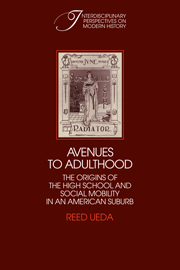Book contents
- Frontmatter
- Contents
- Acknowledgments
- Introduction
- 1 Farm village to commuter suburb
- 2 The evolution of educational leadership
- 3 The free high school
- 4 The rise of Yankee city and the prolongation of schooling
- 5 Popularizing high school: “the college of the people”
- 6 The origins of high school youth culture
- 7 Educational opportunity and social mobility
- 8 The birth of progressive reform and the junior high school
- Conclusion: The high school in the light of history
- Appendix I Courses of study
- Appendix II Sources and methods
- Appendix III Students and households
- Appendix IV Supplementary household data
- Notes
- Index
5 - Popularizing high school: “the college of the people”
Published online by Cambridge University Press: 04 August 2010
- Frontmatter
- Contents
- Acknowledgments
- Introduction
- 1 Farm village to commuter suburb
- 2 The evolution of educational leadership
- 3 The free high school
- 4 The rise of Yankee city and the prolongation of schooling
- 5 Popularizing high school: “the college of the people”
- 6 The origins of high school youth culture
- 7 Educational opportunity and social mobility
- 8 The birth of progressive reform and the junior high school
- Conclusion: The high school in the light of history
- Appendix I Courses of study
- Appendix II Sources and methods
- Appendix III Students and households
- Appendix IV Supplementary household data
- Notes
- Index
Summary
The custodians of public education had promoted the offerings of the high school as the ultimate opportunity of a democratic school system, yet after the Civil War it was still avoided by most youngsters who felt jobs and home duties provided all the necessary preparation for adulthood. The high school suffered unpopularity from a nebulous definition of its role. Only a minority attended, because the rewards of a high school education seemed vague and impractical to many. It did not provide coursework that effectively trained people for attractive jobs, and its college preparatory instruction was inferior to that provided by private academies or tutors. Furthermore, a segment of public opinion continued to question its existence on the grounds of a critique of privilege. In the 1870s, many citizens still argued that the public should not bear the burden of completing the education of the elite who could afford to attend.
Realizing these defects and criticisms, Somerville schoolmen broadened popular support for the high school by transforming it into a nexus with low-white-collar employment, on the one hand, and the expanding colleges of the late nineteenth century, on the other. By the turn of the century, the high school had been restructured to perform this function with a degree of rigor and specialization unforeseen by the common-school reformers who had established it in 1852. As it assumed an unprecedented role as a supply line for the labor market and a conduit to college, it attracted a student population of growing size and ethnic diversity, but one which continued to originate from white-collar and artisan families.
- Type
- Chapter
- Information
- Avenues to AdulthoodThe Origins of the High School and Social Mobility in an American Suburb, pp. 89 - 118Publisher: Cambridge University PressPrint publication year: 1987



